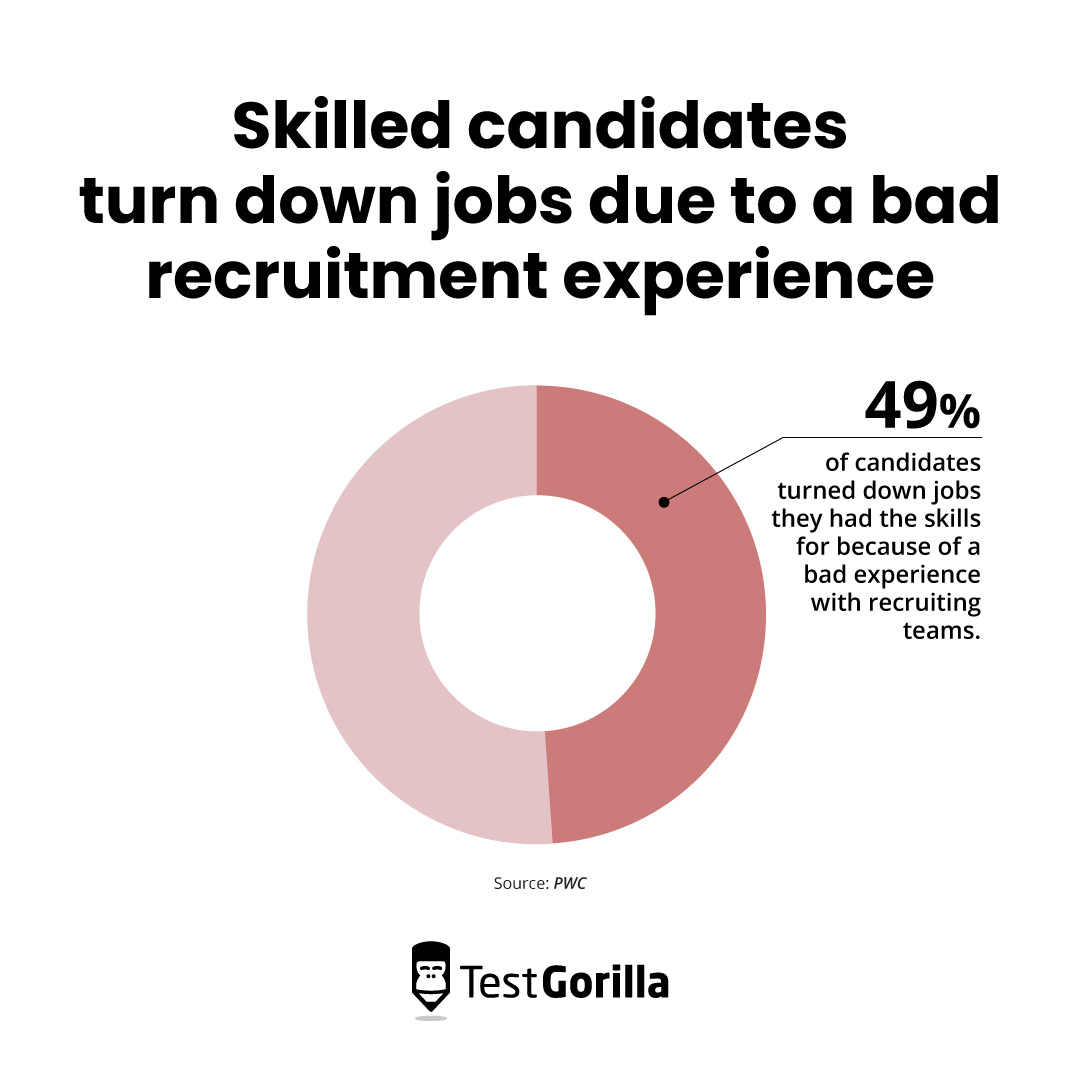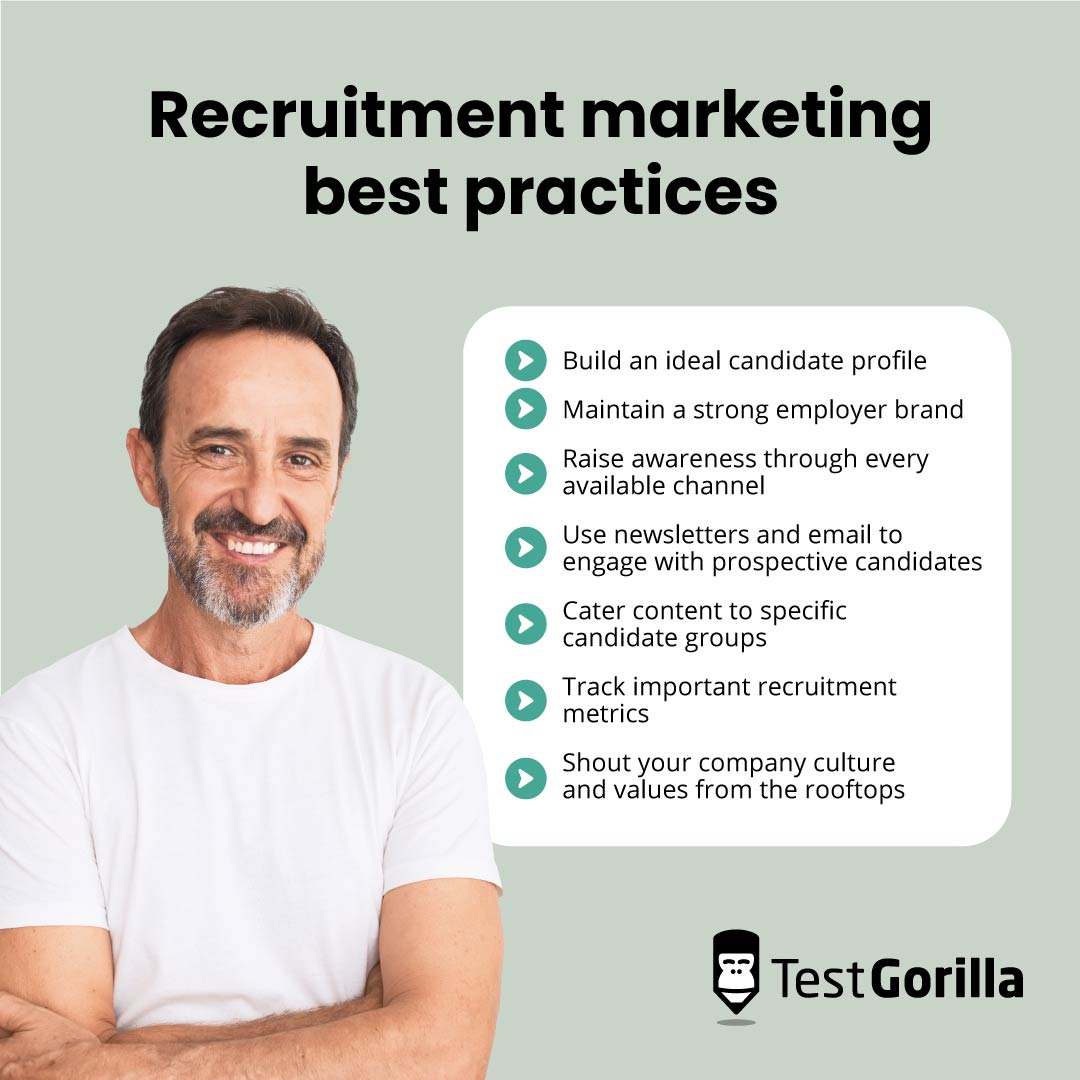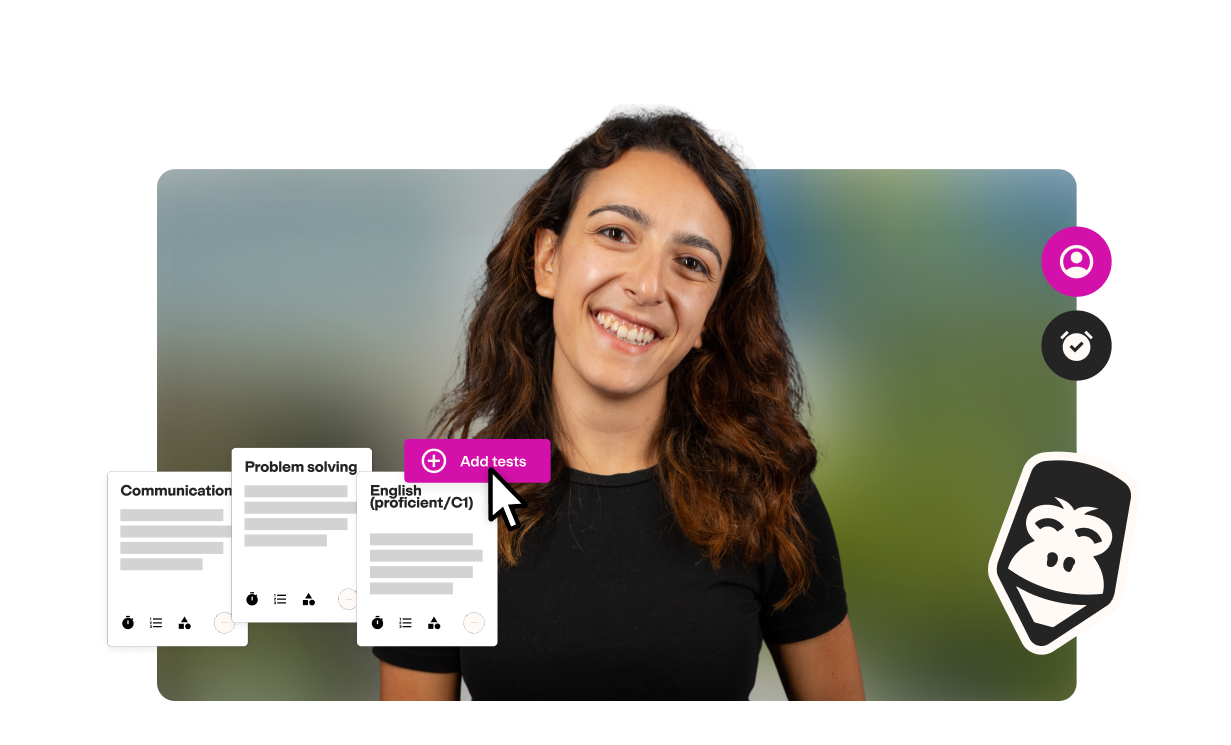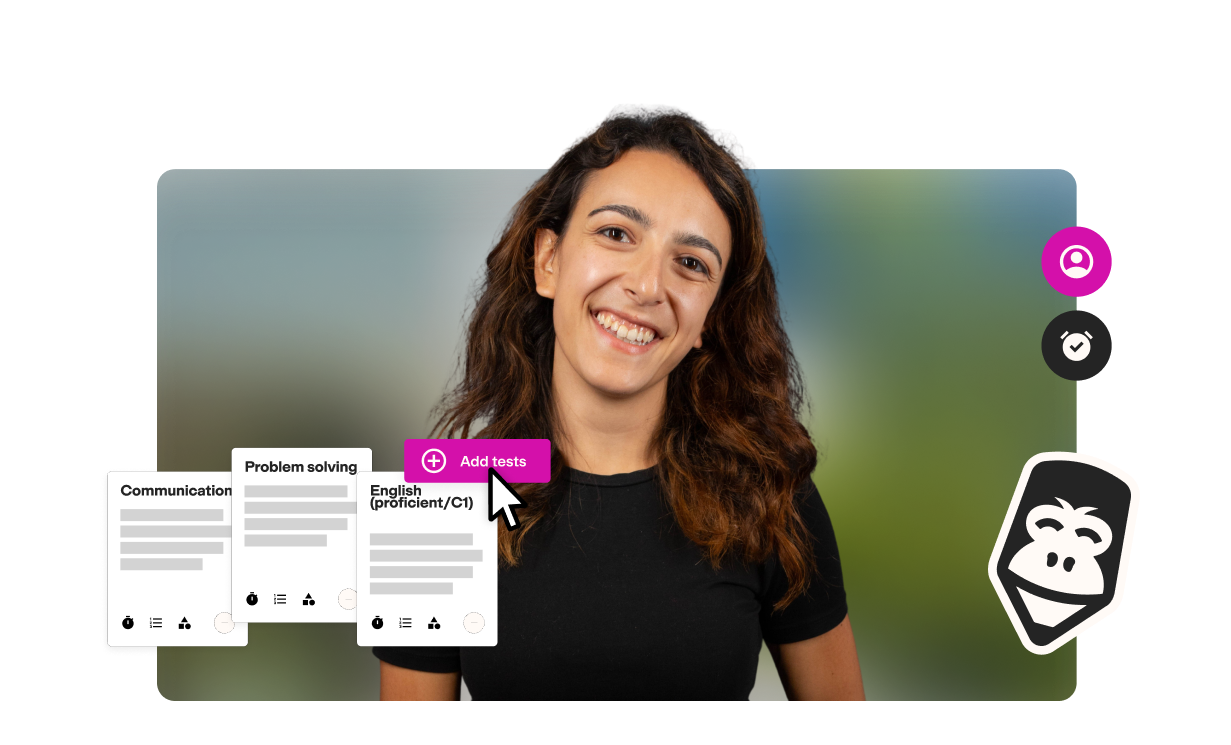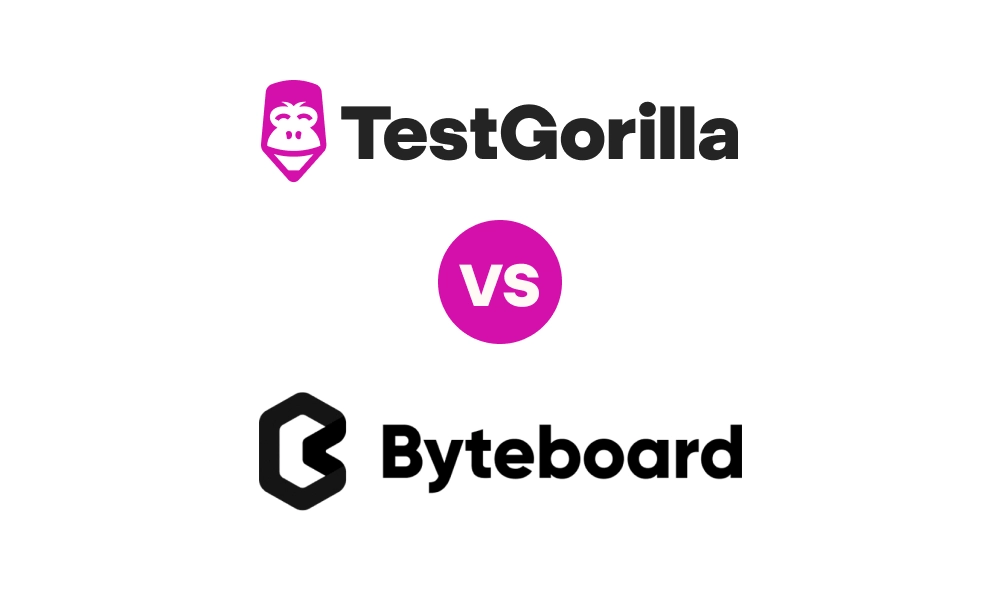Recruitment marketing: How to leverage this talent acquisition trend to nurture the candidate journey
Your business needs to fill a crucial role. You posted the job description in all the usual places, but the applications you’re getting don’t meet the criteria.
Meanwhile, examples of high-quality job seekers who would thrive on your team are all over LinkedIn.
The only problem? They don’t know your company exists.
As a result, you’re failing to reach them – and they’re staying in jobs they don’t like.
That’s why businesses use recruitment marketing.
It’s a popular talent acquisition trend that aims to put your organization in front of top-tier passive candidates. It’s a way to show off your employer branding and optimize your candidates’ experience of your company.
In this guide, we explore how recruitment marketing helps companies attract applications from job candidates whose tested skills meet your needs.
We examine some recruitment marketing success stories and offer actionable tips on marketing your company to candidates.
Table of contents
- What is recruitment marketing?
- Why is a recruitment marketing strategy important?
- The benefits of recruitment marketing
- 7 best practices for leveraging recruitment marketing to acquire top talent
- Recruitment marketing: 4 examples of companies succeeding with this talent acquisition trend
- Make the most of your recruitment marketing campaigns with talent assessments
What is recruitment marketing?
Recruitment marketing is the art of using marketing tactics to promote the value of working for a company.
Or in other words, it’s a trend – even though some would argue it has already become a talent acquisition strategy – that engages potential candidates and encourages them to apply for your business’s open roles.
Common approaches to recruitment marketing include:
Employer branding - Building a brand that shows potential employees your values, your culture, and how you develop your people
Inbound recruiting - Creating engaging content like employee profiles or a blog
Social media recruiting - Using social media platforms to communicate with your talent pool
Candidate experience management - Designing a seamless hiring experience that meets and exceeds applicant expectations
Recruitment analytics - Assessing the effectiveness of your tactics to refine your approach
What’s the difference between recruiting and recruitment marketing?
Recruitment marketing is a strategy that helps the recruiting process – but the two terms aren’t interchangeable.
This table shows the key differences between the two concepts:
| Recruiting | Recruitment marketing |
Main objectives | Introduce candidates to potential jobs | Introduce candidates to your company and its brand through brand awareness |
People involved | Recruiters, hiring managers, HR staff | Recruitment marketers, recruiters, HR staff, content marketers |
Timeline | The immediate term for specific roles | The long term to build an employer brand |
Communication with candidates | One-on-one interactions between candidates and recruiters | One-to-many broadcast communications |
When you make a recruitment marketing plan, you introduce candidates to your recruitment funnel.
Opinions about the number of stages in a recruitment funnel vary, and debates about the value of the funnel model continue to rage, but most people acknowledge these steps:
Awareness – learning that your company exists
Engagement and active search – learning what your company has to offer
Expression of interest – deciding to apply for a job at your firm
Application – applying to work for you
Your recruitment marketing strategies should boost candidate awareness and encourage candidate engagement. From there, candidates can make informed decisions in the later stages of the funnel.
Why is a recruitment marketing strategy important?
In today’s world, candidates discover potential employers like they discover new products.
They browse social media, read online reviews, and use search engines to gather information about career opportunities.
For employers, that information includes your employer brand, company culture, mission, values, and your choice of messaging on the job market.
Those are all things your recruitment marketing team can make clear to potential candidates – especially passive candidates, who comprise an estimated 37% of US workers.
These job seekers aren’t actively looking to start a candidate journey but could be swayed away from their current employers with the right push.
Recruitment marketing aims to pitch your company to those candidates who represent an otherwise untapped talent community.
Good recruitment marketing, driven by data, also enables employers to target their recruiting specifically to relevant applicants.
Targeted data keeps your recruitment processes as efficient as possible and ensures your job opportunities attract a more qualified set of applicants.
But recruitment marketing is also beneficial to candidates. When candidates get a new job they’re qualified for, they’re more likely to have a positive experience during recruitment.
A good candidate experience makes applicants more likely to accept the roles you’re offering them.
Research shows that 49% of candidates turned down jobs they had the skills for because of a bad experience with recruiting teams.
By improving your applicants’ experience with your company, you keep them in your recruitment funnel and improve your ability to hire the best even without an applicant tracking system.
The benefits of recruitment marketing
According to Mike Hennessy, the chief executive officer of SmashFly Technologies, businesses that use recruitment marketing techniques generate three times more leads, 10% more revenue, and a 100% higher close rate.[1]
Those are just a few benefits recruitment marketing unlocks for employers and HR leaders.
But the advantages of a good recruitment marketing strategy are wide-ranging and far-reaching for any business.
Here are some of the biggest benefits that recruitment marketing can offer your company:
The benefits | How they help your business |
Attracts more applicants | Gives you access to a broader, more diverse pool of talent, driving creativity and innovation |
Attracts higher-quality candidates | Improves your likelihood of hiring top-tier candidates into your open positions |
Creates a measurable hiring system | Ensures your hiring process is fair, equitable, and data-led |
Reduces time to hire | Keeps candidates interested and improves the efficiency of your hiring process |
Shows off your company culture | Boosts your likelihood of hiring candidates engaged with your values and mission |
Helps candidates self-select | Keeps the recruitment process efficient for everyone and avoids wasted time |
7 best practices for leveraging recruitment marketing to acquire top talent
Now you know how recruitment marketing can help your business fill every open job.
But how can you use it to the best effect and outreach?
These top tips help your company develop a successful recruitment marketing strategy.
Read on to learn how recruitment marketing can make a material difference to your organization’s efforts to fill job openings.
Recruitment marketing best practices at a glance
If you’re ready to implement best practices, here’s the short version.
Best practice | How it helps |
Build an ideal candidate profile | Enables you to match candidates’ skill sets and abilities to open roles |
Maintain a strong employer brand | Lets candidates know quickly and clearly what your company stands for, empowering them to make informed decisions |
Raise awareness through every available channel | Broadens your reach and increases the size of your applicant pool |
Use newsletters and email to engage with prospective candidates | Approaches potential applicants directly and boosts candidate engagement |
Cater content to specific candidate groups | Ensures your recruitment marketing efforts stay focused and targeted, increasing efficiency |
Track important recruitment metrics | Shows you which of your recruitment marketing techniques are working so you keep refining your approach |
Shout your company culture and values from the rooftops | Makes it easier to reach and recruit candidates who add to your company’s culture |
1. Build an ideal candidate profile
If your job posting is attracting a lot of applications that don’t meet the needs of the role, you may have been unclear about what you’re looking for in a candidate.
An ideal candidate profile (ICP) is a way to set clear expectations about the roles you’re hiring for. Traditional ICPs often contain the following information about what hiring managers expect from candidates:
Hard and soft skills
Work experience
Education and qualifications
The problem is that work experience and qualifications don’t correlate with a candidate’s skills.
If you hire for experience, as you would in traditional recruitment, you may not be hiring the best candidate or doing a favor to your current employees.
An ICP may also specify a candidate’s ideal age or social background, but selecting candidates based on these factors makes it even harder to hire for ability.
At worst, it may be hiring discrimination.
It’s best to keep your ICP closely focused on candidate ability and skills so you can hire the most skilled candidates.
2. Maintain a strong employer brand
Your employer brand is a cornerstone of your corporate identity. It should tell candidates clearly and honestly what your company is about. That includes:
Your mission and purpose
Your values and culture
Your goals
Ideally, every element of your recruitment marketing strategy should reflect your employer brand.
The design of your posts and ads, the voice you use for your job listings, and even the information on your company website should express your employer brand.
Candidates make crucial decisions based on what they understand about a company’s mission, values, and identity.
Being clear about your employer brand helps candidates self-select and make informed choices about where to apply for work.
As an employer, you reap the benefits of this when your candidate pool contains applications from highly qualified people who truly align with your company’s ideals.
It means you waste less time filtering out applications from candidates who won’t add to your culture.
3. Raise awareness through every channel available
Even if your HR team has written the best job posting in the world, it won’t be effective if you don’t share it as widely as possible.
That means ensuring your open role is listed in a broad range of places online, including:
Your company website
LinkedIn, Monster, and other major job posting sites
Facebook, Twitter, and other platforms used in social media recruiting
Any specialist job boards relevant to the role
It’s important to remember that you can find amazing candidates anywhere.
By limiting the places where you advertise your open role, you limit your reach and risk failing to engage highly qualified candidates.
By contrast, if you raise awareness of your hiring efforts across various channels, you increase the size of your talent pipeline and the likelihood of attracting top-tier applicants.
Don’t limit your company by restricting the avenues you use to promote vacancies. Reach out widely, and a wide array of candidates are likely to reach back.
4. Use newsletters and email to engage with prospective candidates
Social media recruitment marketing is a great means of passive recruiting, and it helps businesses broaden their reach.
But it often feels impersonal and may leave some candidates, such as older candidates who aren’t as familiar with social media, in the cold.
Newsletters and emails, on the other hand, feel more personal.
Even when you send them out in bulk via mailing lists and recruitment automation, it feels like you sent them directly to prospective candidates.
That’s especially true when candidates receive emails that go beyond recruitment. Other forms of newsletter content, such as employee profiles and invitations to events, give recipients a better sense of a company’s culture and identity.
Email recruitment marketing is also efficient for companies. It’s a tried and true method that takes up little time and generates substantial returns.
You stand to gain from this approach if you keep the process ethical and avoid spamming recipients.
5. Cater content to specific candidate groups
Not all prospective candidates are interested in the same things.
Gen Z candidates are more likely to care about workplace diversity and good company culture and neurodiverse candidates want to know how your company intends to support them.
Plus, candidates with disabilities are often left out of traditional marketing, especially if they have impairments to their sight or hearing.
Using target candidate personas – fictional representations of your target audience developed based on data – helps businesses target their recruitment marketing efforts.
These aren’t quite the same as ICPs, which help companies write more specific job descriptions.
Instead, a target candidate persona focuses marketing efforts so that qualified candidates are more likely to engage with your business.
ICPs also help ensure that your content is accessible to its intended audience. For example, they offer a useful reminder to include subtitles, sign language, or Braille in your marketing, so disabled candidates can engage.
Creating candidate personas involves a lot of research and is often time-intensive.
But once you’ve identified your target candidates, you have an easier time reaching out to them directly when you do.
6. Track important recruitment metrics
Your recruitment marketing strategy should be a living thing that responds to your business’s needs. You should be able to identify what’s working, what isn’t, and what needs to be improved.
Monitoring your recruitment metrics is the best way to see how to refine your recruitment marketing tactics.
Your business should track important talent acquisition analytics, including:
Lead conversion: How many engaged candidates are making applications?
Time and cost to hire: Are your processes working efficiently?
Source of hire: Which channels are attracting the most candidates?
Applicants per opening: How many candidates are your open roles attracting?
Offer acceptance rate: Are your preferred candidates accepting your offers?
Candidate experience: Are candidates satisfied with the hiring experience?
First-year attrition: Are your new hires leaving soon after getting the job?
This information gives you a clear picture of your approach and its impact and provides a convenient indicator of where to make changes.
7. Shout your company culture and values from the rooftops
Research shows that only four in 10 US employees strongly agree that they know what their company stands for.
Those employees may not contribute to their company culture as fully as they could because HR leaders aren’t communicating clearly.
Your company culture and values are crucial to your employer brand, but that isn’t the whole story.
They’re also important when hiring employees if you want your organization’s culture to remain vibrant and healthy.
Here are the key steps your business needs to take to start hiring for culture add:
Promote your company culture and values in all your recruitment marketing material
Include your culture and values in your ICPs
Hire for culture add using our Culture Add test
Using skills-based hiring methods to test candidates’ culture add potential brings objectivity to a traditionally fuzzy and bias-prone area of hiring and ensures your company culture stays positive and strong.
It helps attract the best talent, not just the right candidates.
Recruitment marketing: 4 examples of companies succeeding with this talent acquisition trend
To understand how recruitment marketing can help you attract top talent, you need to see how it works in practice.
Fortunately, businesses everywhere are using recruitment marketing to great effect.
Read on to discover four amazing examples of recruitment marketing, along with our thoughts on what these businesses did right.
Recruitment marketing examples: 4 success stories at a glance
Successful company | What it does right |
Deloitte | Identifies its target candidates and creates content that engages directly with their interests |
easyJet | Researches and identifies under-accessed pools of talent, then targets them directly based on their wants and needs |
Horizon FCB | Introduces ways to assess candidate skills early in the recruitment process in a shareable format to maximize reach |
Volkswagen | Actively targets passive candidates with the skills necessary to succeed, often recruiting directly from competitor companies |
1. Deloitte
Deloitte, a Big Four consulting firm, struggled to attract younger workers to fill junior roles.
Rather than relying solely on proven staples such as campus recruitment and virtual job fairs, the company branched into television marketing at a carefully-chosen moment.
During the season finale of “The Walking Dead,” AMC's long-running TV show, the firm debuted an ad that took up the show’s zombie theme.
It asked viewers if they were “hungry for an opportunity” before zooming into a zombie hideout and revealing one of its offices.
The ad aimed to reach the television show’s Gen Z and millennial fanbase and engage with them directly on their terms. It drew an association between the media property they loved and the possibilities of working for the company.
Suzanne Kounkel, the firm’s chief marketing officer, reported that the ad that premiered during the TV show generated amazing results. It led to 46,000 visits to the company website and an increased engagement rate of 64%.
With this playful, irreverent ad, the organization reached its target audience and became part of the cultural conversation.
Despite streaming overtaking live TV events, it showed that a TV ad campaign could still bolster recruitment with the right timing.
2. easyJet
easyJet, a low-cost European airline, hasn’t been spared the difficulties plaguing airlines in past years. A shortage of airline pilots and crew members has led to cancellations, delays, and customer frustration all across the industry.
In direct competition with other airlines for top talent, the airline delved into research and produced an intriguing insight.
It learned that 78% of parents over 45 in the UK want to take on new challenges after their children leave home.
The company seized this opportunity and developed a recruitment marketing campaign targeting that demographic on that exact basis.
The ads themselves featured actual crew members from the target demographic, telling their stories of embarking on the adventure of a career in air travel after their children flew the nest.
Using direct employee testimonies, the airline gained credibility with potential candidates, who saw their possibilities reflected in the ad campaign.
The campaign has been successful, with the company seeing a 27% increase in cabin crew members over 45 since 2018. It shows the value of careful demographic research in effective recruitment marketing.
3. Horizon FCB
Horizon FCB, a creative agency based in Dubai, took a bold approach to recruiting a graphic designer.
Instead of posting a straightforward job listing, the company created an ad that it intentionally filled with spelling, grammar, and formatting errors.
It invited candidates to spot all the mistakes, then send feedback, a resume, and a portfolio to a hiring manager for consideration.
Job postings containing puzzles for candidates to solve aren’t, strictly speaking, new. Tech companies use them to recruit technical employees like engineers and coders, which require a high level of attention to detail.
They’re a great way to ascertain a candidate’s key skills at the beginning of the hiring process, speeding things up and keeping recruiting efficient.
They also feel less high-stakes and intimidating than a more rigorous approach might feel at this early stage.
But approaches like this are rare in more creative roles, even when they require all the relevant skills.
The company’s ad invited applicants to exercise their drive to correct mistakes and improve existing work – a crucial criterion for this detail-oriented role.
It was also easy for prospective candidates to share widely, broadening its reach and increasing the firm’s access to top talent.
4. Volkswagen
The French arm of Volkswagen, a car manufacturer, needed to recruit highly skilled mechanics for its garages. But in the automotive industry, 80% of hires are recruited directly from competitors.[2]
That’s because garages need skilled, experienced staff who can hit the ground running and achieve productivity in a short time.
Automotive companies often struggle to engage with their competitors’ employees, many of whom aren’t actively job searching.
The company devised a solution to target passive candidates who hadn’t previously considered searching for an opportunity.
It sent out broken cars to competitor garages and hid invitations to apply for jobs within the company in damaged parts.
If prospective candidates could identify the fault with the car they received, they would find the invitation to apply and a QR code to make the application process as seamless as possible.
This guerrilla approach to recruitment marketing was successful because of its assertiveness. It made the company impossible for passive candidates to ignore and selected top candidates based on their ability level.
The marketing campaign also reached social media when the mechanics targeted by the initiative posted about their experience.
This exposure raised the company’s profile even further among candidates.
Make the most of your recruitment marketing campaigns with talent assessments
Recruitment marketing is a necessary talent acquisition strategy for any company looking to hire top talent and outshine its competitors.
It makes your hiring process more efficient and effective and less likely to result in a bad hire.
Using techniques like ICPs, email marketing, social media marketing, and employer branding, your business stands to increase the size and capability of its talent pool.
You are in the ideal position to make better, smarter hires.
And by monitoring your recruitment metrics closely, you can adjust your recruitment marketing strategy to meet your business’s changing needs over time.
Need to refine your approach to email marketing? Hire the best candidate for the job with our Email Marketing test.
Or, if you want to learn more about assessing the abilities of your newly-engaged candidates, read our scientific guide to ordering tests within a skills assessment.
Sources
Maurer, Roy. (April 4, 2017). “Recruitment Marketing: From Trendy to Necessary”. SHRM. Retrieved July 24, 2023. https://www.shrm.org/resourcesandtools/hr-topics/talent-acquisition/pages/recruitment-marketing-trendy-necessary-smashfly.aspx
“Volkswagen Goes Inside Engines to Offer Jobs to its Competitors”. Little Black Book. Retrieved July 24, 2023. https://www.lbbonline.com/news/volkswagen-goes-inside-engines-to-offer-jobs-to-its-competitors
Related posts
Hire the best candidates with TestGorilla
Create pre-employment assessments in minutes to screen candidates, save time, and hire the best talent.
Latest posts
The best advice in pre-employment testing, in your inbox.
No spam. Unsubscribe at any time.

Hire the best. No bias. No stress.
Our screening tests identify the best candidates and make your hiring decisions faster, easier, and bias-free.
Free resources
This checklist covers key features you should look for when choosing a skills testing platform
This resource will help you develop an onboarding checklist for new hires.
How to assess your candidates' attention to detail.
Learn how to get human resources certified through HRCI or SHRM.
Learn how you can improve the level of talent at your company.
Learn how CapitalT reduced hiring bias with online skills assessments.
Learn how to make the resume process more efficient and more effective.
Improve your hiring strategy with these 7 critical recruitment metrics.
Learn how Sukhi decreased time spent reviewing resumes by 83%!
Hire more efficiently with these hacks that 99% of recruiters aren't using.
Make a business case for diversity and inclusion initiatives with this data.

